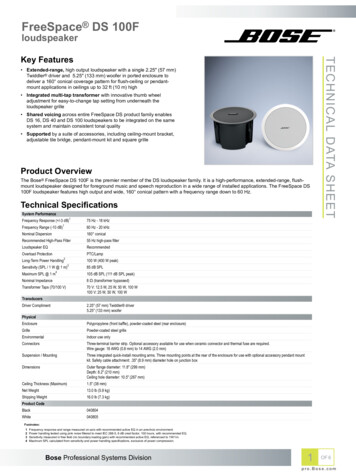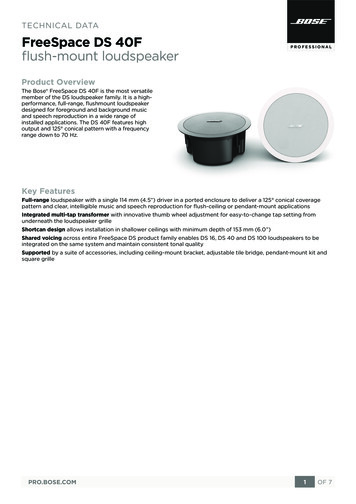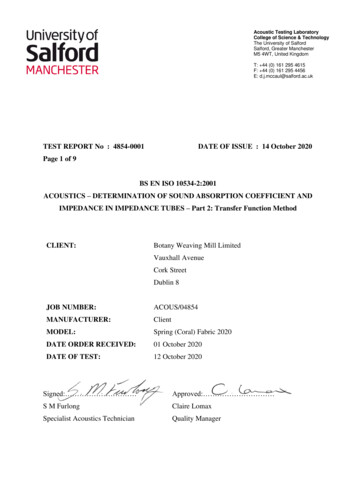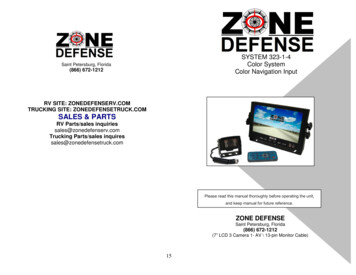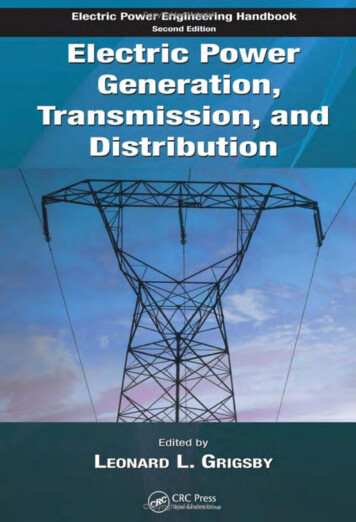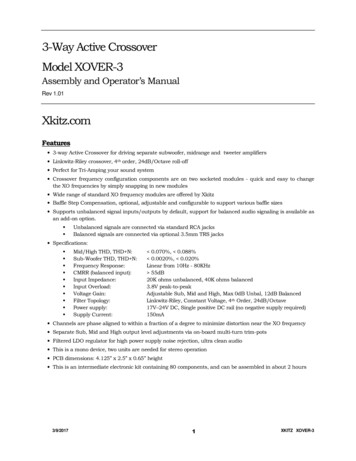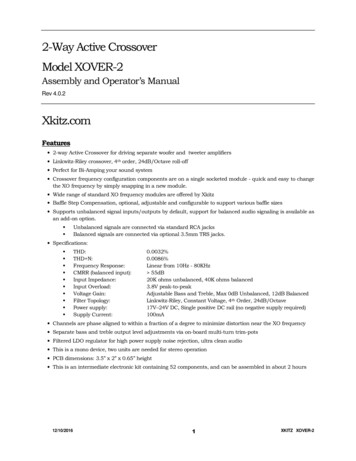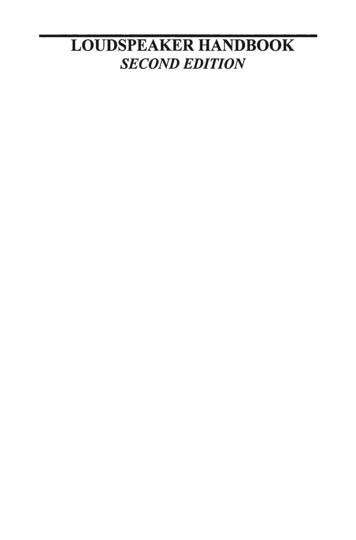
Transcription
LOUDSPEAKER HANDBOOKSECOND EDITION
LOUDSPEAKER HANDBOOKSECOND EDITIONbyJohn EargleJME Consulting CorporationSPRINGER SCIENCE BUSINESS MEDIA, LLC
Library of Congress Cataloging-in-Publication DataEargle, John.Loudspeaker handbook / by John Eargle.--2nd ed.p.cm.Inc1udes bibliographical references and index.ISBN 978-1-4419-5390-2ISBN 978-1-4757-5678-4 (eBook)DOI 10.1007/978-1-4757-5678-41. Loudspeakers--Handbooks, manuals, etc. I. Title.TK5983.E27 2003621.382'84--dc222003058802Copyright 2003 by Springer Science Business Media New YorkOriginally published by Kluwer Academic Publishers in 2003All rights reserved. No part ofthis work may be reproduced, stored in a retrievalsystem, or transmitted in any form or by any means, electronic, mechanical,photocopying, microfilming, recording, or otherwise, without written permissionfrom the Publisher, with the exception of any material supplied specifically for thepurpose ofbeing entered and executed on a computer system, for exclusive use bythe purchaser of the work.Permission for books published in Europe: permissions@wkap.nlPermissions for books published in the United States of America: permissions@wkap.comPrinted an acid-free paper.
CONTENTS:Author's PrefacexiSymbols Used in this BookxiiiChapter 1. Eledroacoustical Engineering Fundamentals:The Dynamic LoudspeakerIntroduction1.1 A simple electrical series resonant circuit1.2 A simple mechanical resonant system1.3 Impedance and mobility analogies1.4 Combining electrical and mechanical domains1.5 Combining mechanical and electrical domains1.6 Directional characteristicsI. 7 Cone excursion, power, and pressurerelationships in graphical formChapter 2. Structural Details of Cone and Dome Drivers:Introduction2.1 Mechanical construction details of thecone driver2.2 The moving system2.3 Variations on the cone driver2.4 HF dome drivers2.5 MF dome drivers2.6 Distortion in come and dome driversChapter 3. Principles of Magnetics:Introduction3.1 Fundamentals3.2 Details of the magnetic circuit3.3 Linearity issues3.4 Temperature rise and demagnetization3.5 Modeling of magnetic phenomena3.6 Magnetic 59
viChapter 4. Low Frequency Systems and Enclosures:Introduction4.1 An introduction to Thiele-Small parameters4.2 Sealed LF system analysis4.3 Ported LF system analysis4.4 Some useful alignments4.5 Port turbulence under high drive conditions4.6 The passive radiator4. 7 Transmission line systems4.8 Dipole LF systems4.9 Multi-chamber LF bandpass systems4.10 The acoustic lever4.11 Transducers in acoustical series and parallel4.12 Slot loading ofLF drivers4.13 Subwoofers4.14 Directional properties of dual LF driversmounted vertically4.15 Alignment shifts636363667376828484878992939597Chapter 5. Dividing Networks and Systems Concepts:Introduction5.1 Basic dividing networks5.2 Upper useful frequency limits for drivers5.3 Some notes on network component quality5.4 Stock networks and autotransformers5.5 Case studies5.6 Off-axis lobing effects5.7 Baftle component layout and edge details5.8 Time domain response of loudspeakers5.9 Loudspeaker dispersion and power response105105105112113114115120123128129Chapter 6. In-line, Planar Loudspeakers, and Arrays:Introduction6.1 Analysis of the constant charge ESL6.2 Electromagnetic planar loudspeakers6.3 Discrete line arrays6.4 Large-scale arrays for sound reinforcement6.5 Programmable arrays13313313 514014415115799101
viiChapter 7. Hom Systems:Introduction7.1 Hom flare profiles7.2 The driving transducer7.3 Analysis of compression drivers7.4 The plane wave tube (PWT)7.5 Secondary resonances in the compression driver7.6 Ring radiators and UHF devices7.7 Families ofhoms7.8 Impedance measurements on horns7.9 Distortion in hom systems7.10 Hom driver protection7.11 Lower midrange and LF hom drivers7.12 LF horns7.13 Hom arraysChapter 8. The Electronic Interface:Introduction8.1 The power amplifier8.2 Line losses8.3 Matching loudspeakers and amplifiers8.4 Amplifier bridging8.5 Multi-amplifying8.6 Electronic control of loudspeaker systemsdynamic performanceChapter 9. Thermal Failure Modes of Loudspeakers:Introduction9.1 Basic heat transfer mechanisms9.2 Estimating values of thermal resistance9.3 Low frequency performance shifts9.4 Techniques for heat removalChapter 10. Recording Monitor Loudspeakers:Introduction10.1 A historical survey10.2 The modem era10.3 Evolution of modem hom HF systems10.4 Modem cone/dome systems10.5 Smaller monitor 246249249250256
viii10.6 Thennodynamic distortion in dome systems10.7 The monitoring environment10.8 The home project studio10.9 Monitor system equalizationChapter 11. Loudspeakers in Speech and MusicReinforcement:Introduction11.1 Systems for speech reinforcement11.2 The role of signal delay11.3 Case studies11.4 Computer simulation of loudspeaker coverage11.5 System equalization11.6 Measurements and estimation of speechintelligibility11.7 Electronic halls11.8 Environmental effects on sound propagation11.9 Systems for high-level music perfonnance11.10 System stabilityChapter 12. Multichannel Systems for Film, Video,and Music:Introduction12.1 Evolution of theater loudspeaker systems12.2 Evolution of theater architecture and acoustics12.3 A professional theater12.4 Theater audio chain calibration12.5 Power bandwidth of audio fonnats for film12.6 Current state-of-the-art in theater loudspeakers12.7 Multichannel video in the home12.8 Overview of music in surround sound12.9 Holographic techniques in surround soundreproduction12.10 Positioning sound sources via reflectionsand 289293297297297303304306309310312316318320
ixChapter 13. Loudspeaker Measurements and Modeting:Introduction13.1 Frequency response measurements13.1 Distortion measurements13.3 Phase and group delay response measurements13.4 Measurement of directional data13.5 The measuring environment13.6 Ground plane measurements13.7 Near-field measurements13.8 An overview of transform measurements13.9 Optical measurements13.10 Modeling techniques13 .11 Destructive testingChapter 14. Loudspeaker Specifications for ProfessionalApplications:Introduction14.1 On-axis frequency response14.2 Impedance14.3 Reference sensitivity ratings14.4 Power ratings of drivers and systems14.5 Power (dynamic) compression14.6 Distortion14.7 Directivity characteristics of systems andcomponents14.8 Thiele-Small parameters14.9 Powered loudspeaker systemsChapter IS. Stereo and the Listening Environment:Introduction15.1 Listening room boundary conditions: thelaboratory meets the real world15.2 Room modes15.3 Room treatment at mid and high frequencies15.4 Optimizing stereophonic localization15.5 Loudspeaker arrangements for extendedstereo imaging15.6 Stereo performance from a single 55356357360361363363364365367367367368372375376379
XChapter 16. A Survey of Unusual Transducers:lntfoduction16.1 Variations on a magnetic theme16.2 Piezo-electric and related devices16.3 Ionized air devices16.4 The air modulator16.5 Rotary actuators16.6 Digital loudspeakers16.7 Distributed mode loudspeakers (DML)16.8 Overview of ultrasonic systemsIndex:385385386396398401403404405408413
AUTHOR'S PREFACE:The second edition of The Loudspeaker Handbook follows the same generaloutline as the first edition and has been augmented and updated in many areasof technology. Most notable here the developments in large-scale,programmable line arrays, distributed mode loudspeakers, and ultrasonic-basedaudio transduction. Additionally, the core chapters on low frequency systems,systems concepts, and hom systems have been expanded.Much of the success of the first edition has been due to its accessibility bothto loudspeaker engineers and to lay technicians working in the field -a pointof view the author maintains in the present work. A full understanding of theunderlying technology requires a fairly rigorous engineering backgroundthrough the second year of professional study. At the same time, the generoususe of graphs, with their intuitive thrust, will be useful to all readers.Here are short descriptions of chapter content:Chapter 1 deals with the basic electro-mechano-acoustical chain between inputto the loudspeaker and its output, with emphasis on the governing equationsand equivalent circuits.Chapter 2 is a survey of cone and dome drivers, the stock-in-trade of theindustry. They are discussed in term s of type, design, performance, andperformance limits.Chapter 3 deals with magnetics. Once a source of difficulty in loudspeakerdesign, magnetics today yields easily to modeling techniques.Chapter 4 discusses low frequency (LF) system performance, primarily fromthe viewpoint ofThiele-Small parameters. We also discuss a wide variety ofenclosure designs.Chapter 5 deals with systems concepts. There is more diversity in this areathan in any other aspect of loudspeaker design. Basic network types, bafflelayout, and component matching are all discussed.Chapter 6 discusses line and planar loudspeakers, including modernelectronically steerable arrays.
xiiChapter 7 covers horns and compression drivers in detail. Hom systems are amainstay of professional sound reinforcement and have been a key element inelectroacoustics from the start.Chapter 8 discusses the electronic interface, including matching loudspeakerand amplifier, series and parallel operation of amplifiers, aspects of multiamplification, and line losses.Chapter 9 deals with the performance shifts associated with heating asloudspeakers are driven to their maximum limits in high-level use. Techniquesfor minimizing these effects are discussed.Chapters 10, 11, and 12 examine the application areas of recording andbroadcast monitoring, sound reinforcement, and motion picture/video,respectively. Current practice in these disciplines is discussed in detail.Chapter 13 covers loudspeaker measurements and modeling. A quiet revolutionhas taken place in the last two decades as measurement systems based ondigital transform techniques have virtually replaced analog systems. Bothmethods are discussed, along with techniques for modeling loudspeakerperformance.Chapter 14 discusses loudspeaker specifications for professional applications.Data presentation is an important first step in this area. Current practice isreviewed.Chapter 15 discusses stereo reproduction the home listening environment alongwith techniques for improvement of room acoustics.Chapter 16 considers the wide variety of physical principles that have beenused over the years for transduction in loudspeakers. Many of these are exoticand transitory, while others have reached a high level of maturity.The author would like acknowledge the many persons at JBL and othercompanies of Harman International Industries for their direct help in gatheringmaterial for this book and for stimulating discussions over the years. Furtherrecognition is given to numerous manufacturers who have provided illustrativematerial for the book. They are gratefully cited in the figure captions.John Eargle,July 2003
Symbols Used in this Book:oo, 23tf, angular frequency (rad/s)A, acoustical wavelength (m)9, independent variable, polar coordinatesp, dependent variable, polar coordinatesp0c, characteristic acoustical impedance of aira, radius (m or mm)A, ampere (SI base unit of electrical current)AF, audio frequencyB, magnetic induction (gauss, G)B, magnetic flux density (tesla, T)BdHd, magnetic gap energy (erg)Br, remnant magnetic induction (gauss)c, speed of sound (m/s)C electrical capacitance (farad, F)C, electrical charge, coulomb (A s)C, mechanical compliance (miN)CMs' compliance, moving systemCP, specific heat of a gas under constant pressure (calories/mol X C)Cv, specific heat of a gas under constant volume (calories/mol X C)Dl, directivity index (dB)e(t), time-varying voltagef(t), time-varying forceH, magnetizing force field, oersted (Oe)He, magnetic coercivity, oerstedHF, high frequencyi(t), time-varying current signali, instantaneous current (A)Jx, Bessel function of order xk, wave number (21t/"A., m-1)kg, kilogram (SI base unit of mass)L, electrical inductance (henry, H)L, liter, unit of volumeI, length of wire in magnetic gap (m)LF, low frequency
xivLP, sound pressure level (re 20 J.tPa)m, meter (SI base unit oflength)M, mass, kg (SI base unit of mass)MAF, minimum audible sound fieldMF, mid frequency s' mass, loudspeaker moving systemN, force, newton (kg m/s2)p(t), time varying pressure (N/s)Q, quality factor; directivity factor (dimensionless)r, radius of circle (m)r, distance (m or mm)R, electrical resistance (ohm, Q)R, mechanical resistance, damping (Ns/m, SI mechanical ohm)RA, radiation impedance (SI acoustical ohm) .voice coil resistance (Q)RF, radio frequency (Hz) 8 , resistance, moving systems, second (SI base unit of time)S0 , cone area (m2)T, tesla, unit of magnetic flux densityTHD, total harmonic distortion (percent)u, instantaneous velocity (m/s)U(t), time varying air volume velocity (m3/s)UHF, ultra high frequencyW, power (watt)WA' acoustical power (watt)x, displacement (m)X, electrical reactance (ohm)Z, electrical impedance (ohm)
Loudspeaker handbook / by John Eargle.--2nd ed. p.cm. Inc1udes bibliographical references and index. ISBN 978-1-4419-5390-2 ISBN 978-1-4757-5678-4 (eBook) . 6.4 Large-scale arrays for sound reinforcement 151 6.5 Programmable arrays 157 . vii Chapter 7. Hom Systems: 161 Introduction 161 7.1 Hom flare profiles 161

